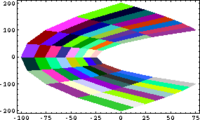0708-1300/Class notes for Tuesday, September 11: Difference between revisions
| Line 74: | Line 74: | ||
5)For every scalar number <math>\alpha</math> it holds <math>d(\alpha f)_{x}=\alpha df_{x}</math> |
5)For every scalar number <math>\alpha</math> it holds <math>d(\alpha f)_{x}=\alpha df_{x}</math> |
||
===Implicit Function Theorem=== |
|||
'''Example''' |
|||
Although <math>x^2+y^2=1</math> does not defines <math>y</math> as a function of <math>x</math> in a neighborhood of <math>(0;-1)</math> we can define <math>g(x)=-\sqrt{1-x^2}</math> so that <math>x^2+g(x)^2=1</math>. Furthermore, <math>g</math> is differentiable with differential <math>dg_{x}=\frac{x}{\sqrt{1-x^2}}</math>. This is a motivation for the following theorem. |
|||
'''Theorem'''(''Implicit function theorem'') |
|||
Let <math>f:\mathbb{R}^n x \mathbb{R}^m\rightarrow \mathbb{R}^m</math> be a ''continuous diffable'' function defined on a neighborhood <math>U</math> of the point <math>(x_0;y_0)</math> and such that <math>f(x_0;y_0)=0</math> |
|||
Revision as of 16:56, 11 September 2007
| ||||||||||||||||||||||||||||||||||||||||||||||||||||||||||||||||||||||||||||||||||||||||||||||||||||||||||||
In Small Scales, Everything's Linear

|

| |
Code in Mathematica:
QuiltPlot[{f_,g_}, {x_, xmin_, xmax_, nx_}, {y_, ymin_, ymax_, ny_}] :=
Module[
{dx, dy, grid, ix, iy},
SeedRandom[1];
dx=(xmax-xmin)/nx;
dy=(ymax-ymin)/ny;
grid = Table[
{x -> xmin+ix*dx, y -> ymin+iy*dy},
{ix, 0, nx}, {iy, 0, ny}
];
grid = Map[({f, g} /. #)&, grid, {2}];
Show[
Graphics[Table[
{
RGBColor[Random[], Random[], Random[]],
Polygon[{
grid[[ix, iy]],
grid[[ix+1, iy]],
grid[[ix+1, iy+1]],
grid[[ix, iy+1]]
}]
},
{ix, nx}, {iy, ny}
]],
Frame -> True
]
]
QuiltPlot[{x, y}, {x, -10, 10, 8}, {y, 5, 10, 8}]
QuiltPlot[{x^2-y^2, 2*x*y}, {x, -10, 10, 8}, {y, 5, 10, 8}]
See also 06-240/Linear Algebra - Why We Care.
Class Notes
Differentiability
Let , and be two normed finite dimensional vector spaces and let be a function defined on a neighborhood of the point
Definition:
We say that is differentiable (diffable) if there is a linear map so that
In this case we will say that is a differential of and will denote it by .
Theorem
If and are diffable maps then the following asertions holds:
1) is unique.
2)
3)If is linear then
4)
5)For every scalar number it holds
Implicit Function Theorem
Example Although does not defines as a function of in a neighborhood of we can define so that . Furthermore, is differentiable with differential . This is a motivation for the following theorem.
Theorem(Implicit function theorem)
Let be a continuous diffable function defined on a neighborhood of the point and such that





























